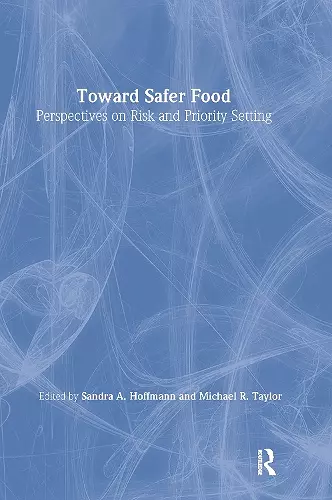Toward Safer Food
Perspectives on Risk and Priority Setting
Michael R Taylor author Sandra Hoffmann author
Format:Paperback
Publisher:Taylor & Francis Inc
Published:25th Feb '05
Currently unavailable, our supplier has not provided us a restock date
This paperback is available in another edition too:
- Hardback£89.99(9781891853890)

In 1998, a National Academy of Sciences panel called for an integrated, risk-based food safety system. This goal is widely embraced, but there has been little advance in thinking about how to integrate knowledge about food safety risks into a system- wide risk analysis framework. Such a framework is the essential scientific basis for better priority setting and resource allocation to improve food safety. Sandra Hoffmann and Michael Taylor bring together leading scientists, risk analysts, and economists, as well as experienced regulators and policy analysts, to better define the priority setting problem and focus on the scientific and intellectual resources available to construct a risk analysis framework for improving food safety. Toward Safer Food provides a common starting point for discussions about how to construct this framework. The book includes a multi-disciplinary introduction to the existing data, research, and methodological and conceptual approaches on which a system-wide risk analysis framework must draw. It also recognizes that efforts to improve food safety will be influenced by the current institutional context, and provides an overview of the ways in which food safety law and administration affect priority setting. Hoffman and Taylor intend their book to be accessible to people from a wide variety of backgrounds. At the same time, they retain the core conceptual sophistication needed to understand the challenges that are inherent in improving food safety. The editors hope that this book will help the U.S. move beyond a call for an integrated, risk-based system toward its actual construction.
'This masterful summary of food safety science and policy is valuable for scholars, students, and concerned citizens. Since 1906, the focus of policy has shifted from addressing gross adulteration to invisible chemical and microbiological hazards that affect both public health and public confidence in the food supply. The authors give a concise survey of what is known about these risks and explain how to use risk analysis to set priorities and use resources more cost-effectively.'
Lester Lave, Carnegie Mellon Tepper School, Carnegie Mellon University
ISBN: 9781891853906
Dimensions: unknown
Weight: 340g
336 pages